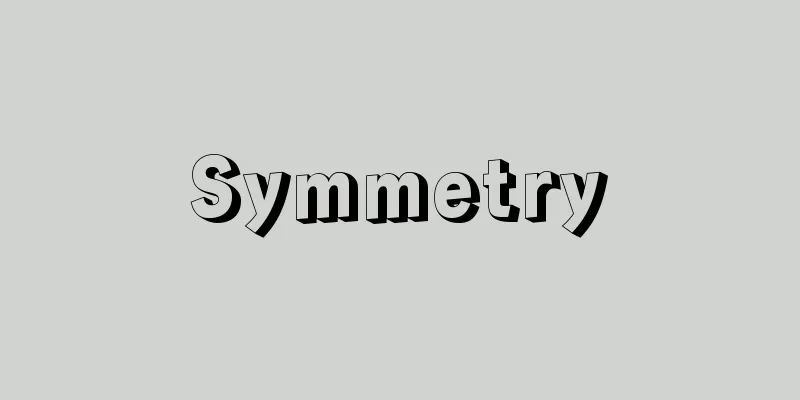Symmetry

|
When the midpoint of two points with respect to a fixed point is the fixed point, the two points are said to be point-symmetric with respect to the fixed point. When the perpendicular bisector of two points with respect to a fixed line coincides with the fixed line, the two points are said to be line-symmetric with respect to the fixed line. Also, when the perpendicular bisector of two points with respect to a fixed plane coincides with the fixed plane, the two points are said to be plane-symmetric with respect to the fixed plane ( ). In each case, one of the two points is called the symmetric point of the other. [Toshio Shibata] Symmetry of Plane FiguresA figure that is created by rotating a plane figure α degrees around a fixed point is called a figure that is rotationally symmetrical by α degrees to the original figure, and that fixed point is called the center of rotational symmetry ( ). Two figures that are rotationally symmetrical by 180 degrees are said to be point symmetrical with respect to the center. A figure that is created by taking a symmetrical point about a fixed line of a figure is called a figure that is linearly symmetrical to the original figure, and that fixed line is called the axis of linear symmetry. The perpendicular bisector of two corresponding points of two linearly symmetric figures coincides with the axis of linear symmetry. In rotational symmetry, the orientation of the figure (the direction of sequentially rotating around the corresponding points) does not change, but in linear symmetry, the orientation of the figure is reversed. Operations that result in rotational symmetry or linear symmetry are called rotationally symmetric or linear symmetric movements. When considering these movements on a plane, the center does not move in rotational symmetry. In linear symmetry, all the points on the axis are stationary. Any movement that does not change the size of a figure on a plane can be found by repeating several linear symmetry movements. For example, translation is a repetition of linearly symmetric translations around two parallel lines, while rotationally symmetric translations are a repetition of linearly symmetric translations around two straight lines passing through the center. When a plane figure is superimposed on itself by a rotation of α degrees, the figure is said to have α-degree rotational symmetry, and the center of rotation is called the center of rotational symmetry of the figure. The temple symbol in is a figure with 90-degree rotational symmetry. When a figure is superimposed on itself by a linearly symmetrical movement, the figure is said to have line symmetry, and the axis of line symmetry is called the axis of symmetry of the figure. An isosceles triangle is a line-symmetric figure with the perpendicular bisector of the base as its axis. A regular polygon is a figure that is both rotationally symmetric and line-symmetric. [Toshio Shibata] Symmetry of solid figuresA figure created by rotating a solid figure α degrees around a fixed line is called a figure with α-degree rotational symmetry to the original figure, and the fixed line is called the axis of rotational symmetry ( ). A figure created by taking a symmetric point about a fixed plane of a figure is called a figure with plane-symmetry to the original figure, and the fixed plane is called the plane of symmetry or mirror plane. The perpendicular bisector of two corresponding points of two plane-symmetric figures coincides with the plane of symmetry. Rotational symmetry and plane-symmetric movements can also be considered in space. A figure created by taking a symmetric point about a fixed point of a figure is called a figure with point-symmetry to the original figure, and its center is called the center of point symmetry, but this is the result of repeatedly performing three plane-symmetric movements on the original figure. [Toshio Shibata] [Reference item] |©Shogakukan "> Symmetric (Fig. A) ©Shogakukan "> Symmetry of plane figures (Figure B) ©Shogakukan "> Symmetry of three-dimensional figures (Figure C) Source: Shogakukan Encyclopedia Nipponica About Encyclopedia Nipponica Information | Legend |
|
一定点に関して2点の中点がその定点であるとき、その2点を定点に関して互いに点対称であるという。一定直線に関して2点の垂直二等分線がその定直線と一致するとき、その2点は定直線に関して互いに線対称であるという。また、一定平面に関して2点の垂直二等分面がその定平面と一致するとき、その2点は定平面に関して互いに面対称であるという()。それぞれの場合、2点の一方を他の対称点という。 [柴田敏男] 平面図形の対称一つの平面図形を一定点の周りにα度回転してできる図形を、初めの図形にα度回転対称な図形といい、その定点を回転対称の中心という()。180度回転対称な二つの図形はその中心に関して点対称であるという。一つの図形の一定直線に関する対称点をとってできる図形を、初めの図形に線対称な図形といい、その定直線を線対称の軸という。線対称な二つの図形の対応する2点の垂直二等分線は、線対称の軸と一致する。回転対称では図形の向き(対応点を順次回る向き)は変わらないが、線対称では図形の向きが逆になる。回転対称や線対称になるようにする操作を回転対称移動、線対称移動という。平面でこれらの移動を考えると、回転対称ではその中心は動かない。線対称ではその軸上の点はすべて不動である。平面で図形の大きさを変えない移動はすべていくつかの線対称移動の繰り返しで求められる。たとえば平行移動は、二つの平行線を軸とする線対称移動の繰り返しであり、回転対称移動は、その中心を通る二つの直線を軸とする線対称移動の繰り返しである。 一つの平面図形がα度回転によって自分自身に重なるとき、その図形をα度回転対称な図形といい、回転の中心をその図形の回転対称の中心という。にあるような寺院の記号は90度回転対称な図形である。一つの図形が線対称移動により自分自身に重なるとき、その図形を線対称な図形といい、線対称の軸をその図形の対称軸という。二等辺三角形は、底辺の垂直二等分線を軸とする線対称な図形である。正多角形は回転対称かつ線対称な図形である。 [柴田敏男] 立体図形の対称一つの立体図形を一定直線の周りにα度回転してできる図形を初めの図形にα度回転対称な図形といい、その定直線を回転対称の軸という()。一つの図形の一定平面に関する対称点をとってできる図形を、初めの図形に面対称な図形といい、その定平面を対称面あるいは鏡映面という。面対称な二つの図形の対応する2点の垂直二等分面は対称面と一致する。空間においても回転対称や面対称の移動を考えることができる。また、一つの図形の一定点に関する対称点をとってできる図形を、初めの図形に点対称な図形といい、その中心を点対称の中心というが、これは、初めの図形に三つの面対称移動を繰り返し施した結果になっている。 [柴田敏男] [参照項目] |©Shogakukan"> 対称〔図A〕 ©Shogakukan"> 平面図形の対称〔図B〕 ©Shogakukan"> 立体図形の対称〔図C〕 出典 小学館 日本大百科全書(ニッポニカ)日本大百科全書(ニッポニカ)について 情報 | 凡例 |
Recommend
Gazetta - Gazetta
…A continuous, irregular news publication started...
Shimazu Genzo
Inventor. First president of Shimadzu Corporation...
Fen Causeway
…The Great Ouse, Nene, Welland, Witham and other ...
Ajikinosho - Ajikinosho
This manor was established in the Ajiki district o...
Bromate
…It is used to produce inorganic bromides such as...
Aeroallergens
...The nasal mucosa becomes edematously swollen b...
Quinoa - quinoa (English spelling)
An annual plant of the family Chenopodiaceae (APG...
Khurramism - Khurramism (English spelling)
A heretical religion with strong anti-Arab and ant...
contessa del vento (English spelling) contessa del vento
…The reason why the clouds appear to be motionles...
Dutch Sekichi - Dutch Sekichi
...The current horticultural species, D. caryophy...
Cabo Catoche (English spelling)
A cape located in the northeastern tip of the Yuca...
The Buddha who attained omniscience - Issaiichijojunyorai
…According to the Sutra of the Bodhisattva Jizo’s...
Nucleon - Hidden
A collective term for the protons and neutrons th...
Siegbahn (English spelling) Karl Manne George Siegbahn
1886‐1978 Swedish physicist. He studied at Lund Un...
《The Court Ladies》
...However, this was probably only possible in th...









